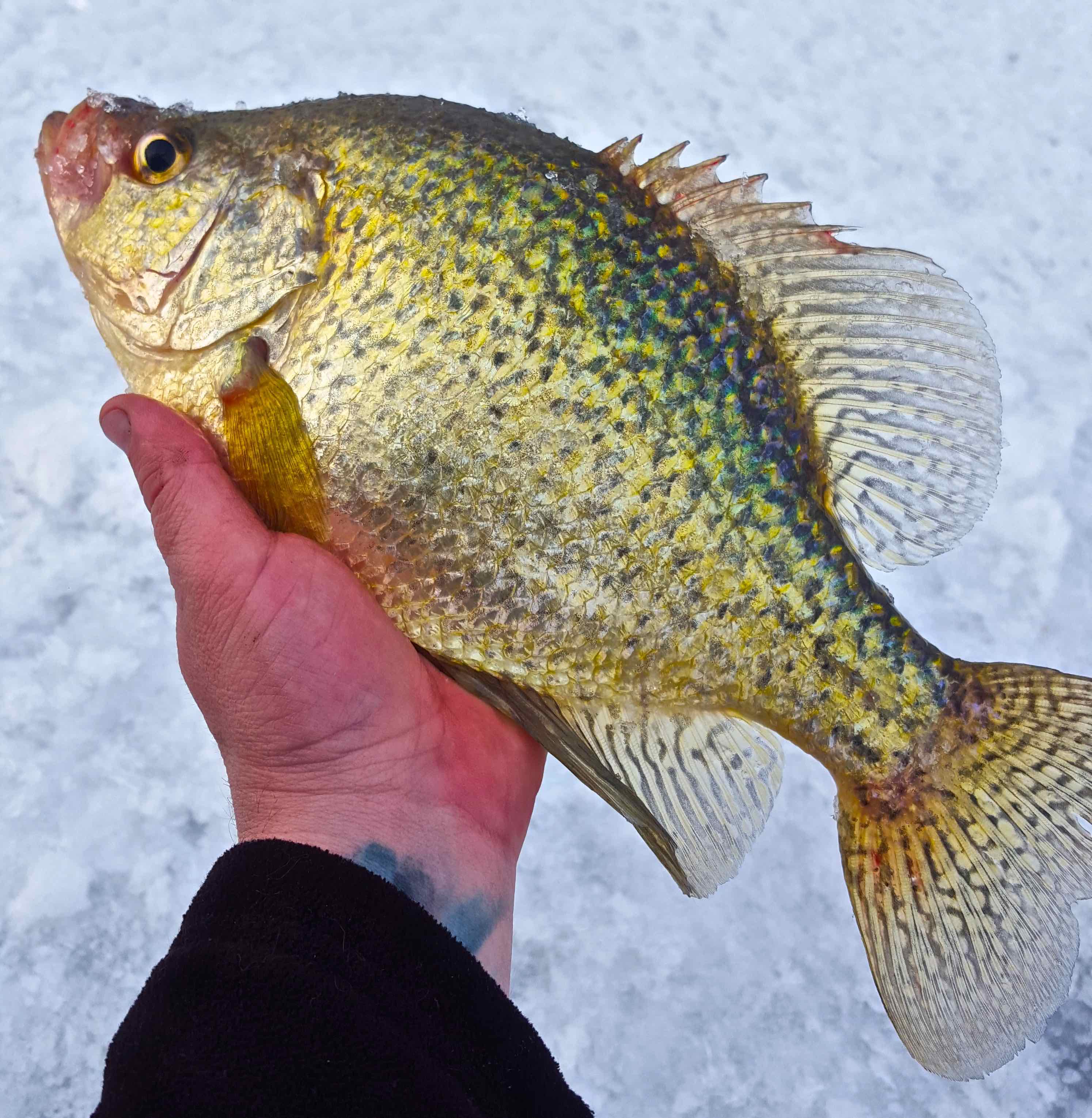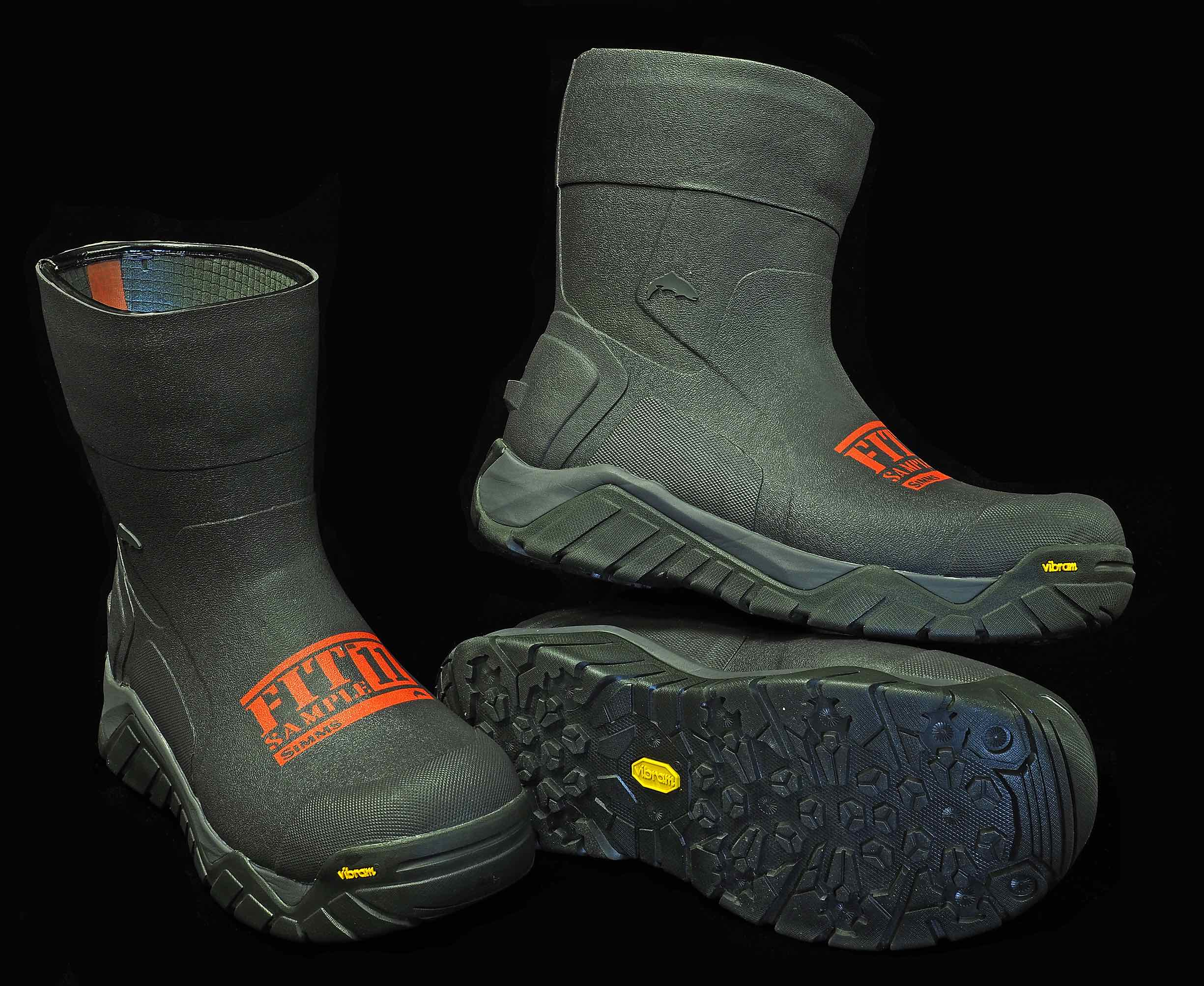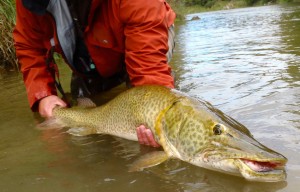Muskellunge (Muskie – Musky)
Muskellunge (Musky / Muskie) are uncommon to a degree, they are large fish that are found in freshwater in North America.
They are the largest member of the pike family.
They are known by other names such as Muskie.
The muskellunge resembles closely the northern pike in their appearance as well as their behavior.
Similar to the other pikes, they are ambush predators and they have a elongated body, anal, dorsal and pelvic fins and a flat head.
 The fish ranges in length but usually is around 2-5 feet, weighing up to 70 pounds.
The fish ranges in length but usually is around 2-5 feet, weighing up to 70 pounds.
The muskellunge is light silver brown or green with dark vertical stripes on its flank.
Sometimes there are no markings on the fish.
In contrast to the northern pike which has a dark body with light markings, the muskellunge has the opposite.
You can also tell the fish apart by the number of sensory pores.
The northern pike never has more than six and the muskellunge has seven.
The fish is found in the Great Lakes region and also in Michigan, Wisconsin and Minnesota.
They also can be found in Canada.
Additionally, the fish has been caught as far south as the Tennessee River valley.
Many Georgia reservoirs have stocked populations of muskellunge.
In Ontario they are found in the Northwest as well as regions of southern and northestern Ontario.
Muskellunge Range in Ontario
In the summer, the fish has two home ranges; a deep range and a shallower one.
The shallow range is usually significantly smaller than the deep range because shallow water heats up in the summer time.
But the fish will continually swim around the water looking for prey and food in the water temperatures that are conducive to him.
The muskellunge or muskies will eat almost anything that it can fit into its mouth.
Their diet mainly consists of fish but it also includes mice, muskrats, ducklings, frogs, crayfish, snakes and other small mammals and small birds.
The fish has a really large mouth and the teeth are needle like.
They like to eat their prey head first. They can eat their prey in one single gulp.
The muskie will actually eat a prey that is up to 30% of their total length.
In the springtime, the muskie prefers smaller prey because their metabolism is running slower.
In the fall, though, they go for the bigger prey as they are preparing for winter.
Similar to the northern pike, a muskellunge will increase in weight as it grows longer.
Their behavior is quite interesting.
They like to form small schools in specific and distinct territories and have sometimes been referred to as gregarious.
Spawning takes place in mid to late spring which is later than the northern pike.
They spawn in shallow vegetated areas.
They prefer sand or rock bottoms for spawning allowing the eggs to not sink and suffocate in mud.
In an attempt to establish dominance over a territory, the males arrive first for spawning.
The period of spawning lasts from five to ten days and is mainly done at nighttime.
Soon after spawning the adult fish leave the eggs.
The embryos that are not eaten by fish, crayfish or insects hatch within two weeks of spawning.
They live on yolk until the mouth is fully developed and then they feed on zooplankton.
Soon afterwards, they begin to be able to prey on fish.
Young muskellunges usually are 12 inches by November 7 of their first year of life.
Related Products
 https://hooklineandsinker.ca/wp-content/uploads/2020/09/Brandon-Upper-Grand-River-Brown-August-2019GGGG-scaled.jpg
1920
2560
HLSAdmin
https://hooklineandsinker.ca/wp-content/uploads/2014/12/Steelheading-in-the-Snow-900-80-Not-Faded-Actual-1030x91.jpg
HLSAdmin2020-09-18 22:35:402020-09-18 22:35:40Improving the quality of future fishing …
https://hooklineandsinker.ca/wp-content/uploads/2020/09/Brandon-Upper-Grand-River-Brown-August-2019GGGG-scaled.jpg
1920
2560
HLSAdmin
https://hooklineandsinker.ca/wp-content/uploads/2014/12/Steelheading-in-the-Snow-900-80-Not-Faded-Actual-1030x91.jpg
HLSAdmin2020-09-18 22:35:402020-09-18 22:35:40Improving the quality of future fishing … https://hooklineandsinker.ca/wp-content/uploads/2016/12/Ian-22-inch-Grand-River-Brown-Trout-CC.jpg
1662
2428
HLSAdmin
https://hooklineandsinker.ca/wp-content/uploads/2014/12/Steelheading-in-the-Snow-900-80-Not-Faded-Actual-1030x91.jpg
HLSAdmin2016-12-19 22:03:142020-08-01 20:58:50Ontario’s Upper Grand River Brown Trout Memories … SALMO TRUTTA
https://hooklineandsinker.ca/wp-content/uploads/2016/12/Ian-22-inch-Grand-River-Brown-Trout-CC.jpg
1662
2428
HLSAdmin
https://hooklineandsinker.ca/wp-content/uploads/2014/12/Steelheading-in-the-Snow-900-80-Not-Faded-Actual-1030x91.jpg
HLSAdmin2016-12-19 22:03:142020-08-01 20:58:50Ontario’s Upper Grand River Brown Trout Memories … SALMO TRUTTA https://hooklineandsinker.ca/wp-content/uploads/2016/12/Saugeen-River-Steelhead-October-21st-2016AAA.jpg
1646
2679
HLSAdmin
https://hooklineandsinker.ca/wp-content/uploads/2014/12/Steelheading-in-the-Snow-900-80-Not-Faded-Actual-1030x91.jpg
HLSAdmin2016-12-19 20:25:042017-01-29 19:44:44Ontario Steelhead Memories … ONCORHYNCHUS MYKISS … “The Gray Ghost”
https://hooklineandsinker.ca/wp-content/uploads/2016/12/Saugeen-River-Steelhead-October-21st-2016AAA.jpg
1646
2679
HLSAdmin
https://hooklineandsinker.ca/wp-content/uploads/2014/12/Steelheading-in-the-Snow-900-80-Not-Faded-Actual-1030x91.jpg
HLSAdmin2016-12-19 20:25:042017-01-29 19:44:44Ontario Steelhead Memories … ONCORHYNCHUS MYKISS … “The Gray Ghost” https://hooklineandsinker.ca/wp-content/uploads/2017/04/Fairy-Lake-Crayfish-March-2017AAA.jpg
2204
2012
HLSAdmin
https://hooklineandsinker.ca/wp-content/uploads/2014/12/Steelheading-in-the-Snow-900-80-Not-Faded-Actual-1030x91.jpg
HLSAdmin2017-04-02 20:11:562019-08-11 20:10:37Crayfish
https://hooklineandsinker.ca/wp-content/uploads/2017/04/Fairy-Lake-Crayfish-March-2017AAA.jpg
2204
2012
HLSAdmin
https://hooklineandsinker.ca/wp-content/uploads/2014/12/Steelheading-in-the-Snow-900-80-Not-Faded-Actual-1030x91.jpg
HLSAdmin2017-04-02 20:11:562019-08-11 20:10:37Crayfish https://hooklineandsinker.ca/wp-content/uploads/2014/11/Guelph-Lake-Largemouth-Bass-Ultra-Tungsten-12-ounce-Spinnerbait-AAA.jpg
2137
2078
Ray Collesso
https://hooklineandsinker.ca/wp-content/uploads/2014/12/Steelheading-in-the-Snow-900-80-Not-Faded-Actual-1030x91.jpg
Ray Collesso2014-11-24 19:24:012017-04-06 10:40:37Largemouth Bass
https://hooklineandsinker.ca/wp-content/uploads/2014/11/Guelph-Lake-Largemouth-Bass-Ultra-Tungsten-12-ounce-Spinnerbait-AAA.jpg
2137
2078
Ray Collesso
https://hooklineandsinker.ca/wp-content/uploads/2014/12/Steelheading-in-the-Snow-900-80-Not-Faded-Actual-1030x91.jpg
Ray Collesso2014-11-24 19:24:012017-04-06 10:40:37Largemouth Bass https://hooklineandsinker.ca/wp-content/uploads/2015/01/Guelph-Lake-Rock-Bass-AAA.jpg
706
934
HLSAdmin
https://hooklineandsinker.ca/wp-content/uploads/2014/12/Steelheading-in-the-Snow-900-80-Not-Faded-Actual-1030x91.jpg
HLSAdmin2015-01-01 21:22:012019-08-10 23:03:54Rock Bass
https://hooklineandsinker.ca/wp-content/uploads/2015/01/Guelph-Lake-Rock-Bass-AAA.jpg
706
934
HLSAdmin
https://hooklineandsinker.ca/wp-content/uploads/2014/12/Steelheading-in-the-Snow-900-80-Not-Faded-Actual-1030x91.jpg
HLSAdmin2015-01-01 21:22:012019-08-10 23:03:54Rock Bass https://hooklineandsinker.ca/wp-content/uploads/2014/01/Grand-River-Streamer-Smallmouth-Bass-300x225.jpg
225
300
Ray Collesso
https://hooklineandsinker.ca/wp-content/uploads/2014/12/Steelheading-in-the-Snow-900-80-Not-Faded-Actual-1030x91.jpg
Ray Collesso2014-11-24 19:28:592019-08-11 21:15:14Smallmouth Bass
https://hooklineandsinker.ca/wp-content/uploads/2014/01/Grand-River-Streamer-Smallmouth-Bass-300x225.jpg
225
300
Ray Collesso
https://hooklineandsinker.ca/wp-content/uploads/2014/12/Steelheading-in-the-Snow-900-80-Not-Faded-Actual-1030x91.jpg
Ray Collesso2014-11-24 19:28:592019-08-11 21:15:14Smallmouth Bass https://hooklineandsinker.ca/wp-content/uploads/2014/11/bluegill-2.jpg
1270
2040
Ray Collesso
https://hooklineandsinker.ca/wp-content/uploads/2014/12/Steelheading-in-the-Snow-900-80-Not-Faded-Actual-1030x91.jpg
Ray Collesso2014-11-24 19:11:332017-04-06 10:43:45Bluegill
https://hooklineandsinker.ca/wp-content/uploads/2014/11/bluegill-2.jpg
1270
2040
Ray Collesso
https://hooklineandsinker.ca/wp-content/uploads/2014/12/Steelheading-in-the-Snow-900-80-Not-Faded-Actual-1030x91.jpg
Ray Collesso2014-11-24 19:11:332017-04-06 10:43:45Bluegill https://hooklineandsinker.ca/wp-content/uploads/2018/07/Matt-Bowfin-CCC.jpg
2305
2420
HLSAdmin
https://hooklineandsinker.ca/wp-content/uploads/2014/12/Steelheading-in-the-Snow-900-80-Not-Faded-Actual-1030x91.jpg
HLSAdmin2018-07-25 22:25:182020-07-20 20:47:45Bowfin or Dogfish
https://hooklineandsinker.ca/wp-content/uploads/2018/07/Matt-Bowfin-CCC.jpg
2305
2420
HLSAdmin
https://hooklineandsinker.ca/wp-content/uploads/2014/12/Steelheading-in-the-Snow-900-80-Not-Faded-Actual-1030x91.jpg
HLSAdmin2018-07-25 22:25:182020-07-20 20:47:45Bowfin or Dogfish https://hooklineandsinker.ca/wp-content/uploads/2015/06/Guelph-Lake-Bulhead-Catfish-AAA.jpg
1913
1751
HLSAdmin
https://hooklineandsinker.ca/wp-content/uploads/2014/12/Steelheading-in-the-Snow-900-80-Not-Faded-Actual-1030x91.jpg
HLSAdmin2015-06-02 22:56:082017-08-29 18:32:24Brown Bullhead
https://hooklineandsinker.ca/wp-content/uploads/2015/06/Guelph-Lake-Bulhead-Catfish-AAA.jpg
1913
1751
HLSAdmin
https://hooklineandsinker.ca/wp-content/uploads/2014/12/Steelheading-in-the-Snow-900-80-Not-Faded-Actual-1030x91.jpg
HLSAdmin2015-06-02 22:56:082017-08-29 18:32:24Brown Bullhead https://hooklineandsinker.ca/wp-content/uploads/2015/01/Burbot-or-Ling-Ice-Fishing-AAAA-scaled.jpg
1731
2560
HLSAdmin
https://hooklineandsinker.ca/wp-content/uploads/2014/12/Steelheading-in-the-Snow-900-80-Not-Faded-Actual-1030x91.jpg
HLSAdmin2015-01-01 21:37:552021-03-07 00:21:04Burbot or Ling
https://hooklineandsinker.ca/wp-content/uploads/2015/01/Burbot-or-Ling-Ice-Fishing-AAAA-scaled.jpg
1731
2560
HLSAdmin
https://hooklineandsinker.ca/wp-content/uploads/2014/12/Steelheading-in-the-Snow-900-80-Not-Faded-Actual-1030x91.jpg
HLSAdmin2015-01-01 21:37:552021-03-07 00:21:04Burbot or Ling https://hooklineandsinker.ca/wp-content/uploads/2014/01/Carp-on-the-Fly-Rod-Thames-River-HH.jpg
1891
3087
HLSAdmin
https://hooklineandsinker.ca/wp-content/uploads/2014/12/Steelheading-in-the-Snow-900-80-Not-Faded-Actual-1030x91.jpg
HLSAdmin2015-01-01 21:04:412020-07-20 19:40:40Common Carp
https://hooklineandsinker.ca/wp-content/uploads/2014/01/Carp-on-the-Fly-Rod-Thames-River-HH.jpg
1891
3087
HLSAdmin
https://hooklineandsinker.ca/wp-content/uploads/2014/12/Steelheading-in-the-Snow-900-80-Not-Faded-Actual-1030x91.jpg
HLSAdmin2015-01-01 21:04:412020-07-20 19:40:40Common Carp https://hooklineandsinker.ca/wp-content/uploads/2014/10/Catfish-Rapala-Centerpin-Float-Reel-AA.jpg
2325
1836
Ray Collesso
https://hooklineandsinker.ca/wp-content/uploads/2014/12/Steelheading-in-the-Snow-900-80-Not-Faded-Actual-1030x91.jpg
Ray Collesso2014-11-24 19:20:532017-04-06 10:46:03Channel Catfish
https://hooklineandsinker.ca/wp-content/uploads/2014/10/Catfish-Rapala-Centerpin-Float-Reel-AA.jpg
2325
1836
Ray Collesso
https://hooklineandsinker.ca/wp-content/uploads/2014/12/Steelheading-in-the-Snow-900-80-Not-Faded-Actual-1030x91.jpg
Ray Collesso2014-11-24 19:20:532017-04-06 10:46:03Channel Catfish https://hooklineandsinker.ca/wp-content/uploads/2015/04/Creek-Chub1.jpg
874
2048
HLSAdmin
https://hooklineandsinker.ca/wp-content/uploads/2014/12/Steelheading-in-the-Snow-900-80-Not-Faded-Actual-1030x91.jpg
HLSAdmin2015-04-05 19:28:012020-06-11 20:48:54Creek Chub
https://hooklineandsinker.ca/wp-content/uploads/2015/04/Creek-Chub1.jpg
874
2048
HLSAdmin
https://hooklineandsinker.ca/wp-content/uploads/2014/12/Steelheading-in-the-Snow-900-80-Not-Faded-Actual-1030x91.jpg
HLSAdmin2015-04-05 19:28:012020-06-11 20:48:54Creek Chub https://hooklineandsinker.ca/wp-content/uploads/2015/05/Upper-Grand-River-Horny-Creek-Chub-AAA.jpg
2617
2386
HLSAdmin
https://hooklineandsinker.ca/wp-content/uploads/2014/12/Steelheading-in-the-Snow-900-80-Not-Faded-Actual-1030x91.jpg
HLSAdmin2015-05-26 23:09:332020-06-11 20:45:34River and Hornyhead Chub
https://hooklineandsinker.ca/wp-content/uploads/2015/05/Upper-Grand-River-Horny-Creek-Chub-AAA.jpg
2617
2386
HLSAdmin
https://hooklineandsinker.ca/wp-content/uploads/2014/12/Steelheading-in-the-Snow-900-80-Not-Faded-Actual-1030x91.jpg
HLSAdmin2015-05-26 23:09:332020-06-11 20:45:34River and Hornyhead Chub https://hooklineandsinker.ca/wp-content/uploads/2014/11/Crappie-through-the-Ice-Guelph-Lake-AAA.jpg
3059
2988
Ray Collesso
https://hooklineandsinker.ca/wp-content/uploads/2014/12/Steelheading-in-the-Snow-900-80-Not-Faded-Actual-1030x91.jpg
Ray Collesso2014-11-24 19:07:442020-03-03 21:13:12Black Crappie
https://hooklineandsinker.ca/wp-content/uploads/2014/11/Crappie-through-the-Ice-Guelph-Lake-AAA.jpg
3059
2988
Ray Collesso
https://hooklineandsinker.ca/wp-content/uploads/2014/12/Steelheading-in-the-Snow-900-80-Not-Faded-Actual-1030x91.jpg
Ray Collesso2014-11-24 19:07:442020-03-03 21:13:12Black Crappie https://hooklineandsinker.ca/wp-content/uploads/2015/01/Steve-Freshwater-Sheephead-Drum-Hamilton-DDD.jpg
1628
2043
HLSAdmin
https://hooklineandsinker.ca/wp-content/uploads/2014/12/Steelheading-in-the-Snow-900-80-Not-Faded-Actual-1030x91.jpg
HLSAdmin2015-01-01 20:59:002018-01-14 22:12:29Freshwater Drum or Sheephead
https://hooklineandsinker.ca/wp-content/uploads/2015/01/Steve-Freshwater-Sheephead-Drum-Hamilton-DDD.jpg
1628
2043
HLSAdmin
https://hooklineandsinker.ca/wp-content/uploads/2014/12/Steelheading-in-the-Snow-900-80-Not-Faded-Actual-1030x91.jpg
HLSAdmin2015-01-01 20:59:002018-01-14 22:12:29Freshwater Drum or Sheephead https://hooklineandsinker.ca/wp-content/uploads/2016/05/Mooneye-Fishing-on-the-Lower-Grand-Rver-BBB.jpg
853
1280
HLSAdmin
https://hooklineandsinker.ca/wp-content/uploads/2014/12/Steelheading-in-the-Snow-900-80-Not-Faded-Actual-1030x91.jpg
HLSAdmin2016-05-14 20:18:122017-04-06 10:57:24Mooneye
https://hooklineandsinker.ca/wp-content/uploads/2016/05/Mooneye-Fishing-on-the-Lower-Grand-Rver-BBB.jpg
853
1280
HLSAdmin
https://hooklineandsinker.ca/wp-content/uploads/2014/12/Steelheading-in-the-Snow-900-80-Not-Faded-Actual-1030x91.jpg
HLSAdmin2016-05-14 20:18:122017-04-06 10:57:24Mooneye https://hooklineandsinker.ca/wp-content/uploads/2015/01/Saugeen-River-Musky-A.jpg
2087
3265
HLSAdmin
https://hooklineandsinker.ca/wp-content/uploads/2014/12/Steelheading-in-the-Snow-900-80-Not-Faded-Actual-1030x91.jpg
HLSAdmin2015-01-01 21:43:512017-06-17 19:48:44Muskellunge (Musky / Muskie)
https://hooklineandsinker.ca/wp-content/uploads/2015/01/Saugeen-River-Musky-A.jpg
2087
3265
HLSAdmin
https://hooklineandsinker.ca/wp-content/uploads/2014/12/Steelheading-in-the-Snow-900-80-Not-Faded-Actual-1030x91.jpg
HLSAdmin2015-01-01 21:43:512017-06-17 19:48:44Muskellunge (Musky / Muskie) https://hooklineandsinker.ca/wp-content/uploads/2014/11/Perch-Guelph-Lake-Ice-Fishing-A.jpg
1096
2448
Ray Collesso
https://hooklineandsinker.ca/wp-content/uploads/2014/12/Steelheading-in-the-Snow-900-80-Not-Faded-Actual-1030x91.jpg
Ray Collesso2014-11-30 21:57:452017-04-06 11:00:20Yellow Perch (“Jumbo” Perch)
https://hooklineandsinker.ca/wp-content/uploads/2014/11/Perch-Guelph-Lake-Ice-Fishing-A.jpg
1096
2448
Ray Collesso
https://hooklineandsinker.ca/wp-content/uploads/2014/12/Steelheading-in-the-Snow-900-80-Not-Faded-Actual-1030x91.jpg
Ray Collesso2014-11-30 21:57:452017-04-06 11:00:20Yellow Perch (“Jumbo” Perch) https://hooklineandsinker.ca/wp-content/uploads/2015/04/Longnose-Gar-Pike-Kawarthas-A.jpg
218
606
HLSAdmin
https://hooklineandsinker.ca/wp-content/uploads/2014/12/Steelheading-in-the-Snow-900-80-Not-Faded-Actual-1030x91.jpg
HLSAdmin2015-04-05 21:57:362019-07-27 20:48:24Longnose Gar Pike
https://hooklineandsinker.ca/wp-content/uploads/2015/04/Longnose-Gar-Pike-Kawarthas-A.jpg
218
606
HLSAdmin
https://hooklineandsinker.ca/wp-content/uploads/2014/12/Steelheading-in-the-Snow-900-80-Not-Faded-Actual-1030x91.jpg
HLSAdmin2015-04-05 21:57:362019-07-27 20:48:24Longnose Gar Pike https://hooklineandsinker.ca/wp-content/uploads/2014/10/Northern-Pike-Chartreuse-Trout-Bead-Okuma-Raw-Float-Reel-Resized.jpg
740
840
Ray Collesso
https://hooklineandsinker.ca/wp-content/uploads/2014/12/Steelheading-in-the-Snow-900-80-Not-Faded-Actual-1030x91.jpg
Ray Collesso2014-11-24 19:35:422017-04-06 11:07:27Northern Pike
https://hooklineandsinker.ca/wp-content/uploads/2014/10/Northern-Pike-Chartreuse-Trout-Bead-Okuma-Raw-Float-Reel-Resized.jpg
740
840
Ray Collesso
https://hooklineandsinker.ca/wp-content/uploads/2014/12/Steelheading-in-the-Snow-900-80-Not-Faded-Actual-1030x91.jpg
Ray Collesso2014-11-24 19:35:422017-04-06 11:07:27Northern Pike https://hooklineandsinker.ca/wp-content/uploads/2015/03/Upper-Grand-River-Walleye-on-a-Bead-Head-Nymph-AA.jpg
2684
4575
Ray Collesso
https://hooklineandsinker.ca/wp-content/uploads/2014/12/Steelheading-in-the-Snow-900-80-Not-Faded-Actual-1030x91.jpg
Ray Collesso2014-11-24 19:33:332018-09-15 20:32:28Pickerel or Walleye
https://hooklineandsinker.ca/wp-content/uploads/2015/03/Upper-Grand-River-Walleye-on-a-Bead-Head-Nymph-AA.jpg
2684
4575
Ray Collesso
https://hooklineandsinker.ca/wp-content/uploads/2014/12/Steelheading-in-the-Snow-900-80-Not-Faded-Actual-1030x91.jpg
Ray Collesso2014-11-24 19:33:332018-09-15 20:32:28Pickerel or Walleye https://hooklineandsinker.ca/wp-content/uploads/2015/04/Jim-Boni-Atlantic-Salmon-Petite-Cascapedia-22lbs-AAA.13.jpg
1201
2838
HLSAdmin
https://hooklineandsinker.ca/wp-content/uploads/2014/12/Steelheading-in-the-Snow-900-80-Not-Faded-Actual-1030x91.jpg
HLSAdmin2015-04-27 22:53:112019-07-24 20:59:48Atlantic Salmon
https://hooklineandsinker.ca/wp-content/uploads/2015/04/Jim-Boni-Atlantic-Salmon-Petite-Cascapedia-22lbs-AAA.13.jpg
1201
2838
HLSAdmin
https://hooklineandsinker.ca/wp-content/uploads/2014/12/Steelheading-in-the-Snow-900-80-Not-Faded-Actual-1030x91.jpg
HLSAdmin2015-04-27 22:53:112019-07-24 20:59:48Atlantic Salmon https://hooklineandsinker.ca/wp-content/uploads/2015/03/Early-Lake-Huron-Chinook-Salmon-on-the-Centerpin-Float-Rod-AAA.jpg
1851
3005
HLSAdmin
https://hooklineandsinker.ca/wp-content/uploads/2014/12/Steelheading-in-the-Snow-900-80-Not-Faded-Actual-1030x91.jpg
HLSAdmin2015-03-30 22:01:062017-10-27 17:01:28Chinook Salmon ( King Salmon )
https://hooklineandsinker.ca/wp-content/uploads/2015/03/Early-Lake-Huron-Chinook-Salmon-on-the-Centerpin-Float-Rod-AAA.jpg
1851
3005
HLSAdmin
https://hooklineandsinker.ca/wp-content/uploads/2014/12/Steelheading-in-the-Snow-900-80-Not-Faded-Actual-1030x91.jpg
HLSAdmin2015-03-30 22:01:062017-10-27 17:01:28Chinook Salmon ( King Salmon ) https://hooklineandsinker.ca/wp-content/uploads/2015/07/Common-Shiner-AA.jpg
2776
1328
HLSAdmin
https://hooklineandsinker.ca/wp-content/uploads/2014/12/Steelheading-in-the-Snow-900-80-Not-Faded-Actual-1030x91.jpg
HLSAdmin2015-07-09 22:02:292017-04-06 11:22:41Common Shiner
https://hooklineandsinker.ca/wp-content/uploads/2015/07/Common-Shiner-AA.jpg
2776
1328
HLSAdmin
https://hooklineandsinker.ca/wp-content/uploads/2014/12/Steelheading-in-the-Snow-900-80-Not-Faded-Actual-1030x91.jpg
HLSAdmin2015-07-09 22:02:292017-04-06 11:22:41Common Shiner https://hooklineandsinker.ca/wp-content/uploads/2014/09/Steelhead-HLS-UV-Nuclear-Chartreuse-Beads-Slider-AA.jpg
863
2448
Ray Collesso
https://hooklineandsinker.ca/wp-content/uploads/2014/12/Steelheading-in-the-Snow-900-80-Not-Faded-Actual-1030x91.jpg
Ray Collesso2014-11-26 17:23:152017-04-06 11:25:03Steelhead
https://hooklineandsinker.ca/wp-content/uploads/2014/09/Steelhead-HLS-UV-Nuclear-Chartreuse-Beads-Slider-AA.jpg
863
2448
Ray Collesso
https://hooklineandsinker.ca/wp-content/uploads/2014/12/Steelheading-in-the-Snow-900-80-Not-Faded-Actual-1030x91.jpg
Ray Collesso2014-11-26 17:23:152017-04-06 11:25:03Steelhead https://hooklineandsinker.ca/wp-content/uploads/2015/02/Sucker-Float-Centerpin-Fishing-Mad-River-Bead-Raven-Fixed-Float-BB.jpg
1966
1124
HLSAdmin
https://hooklineandsinker.ca/wp-content/uploads/2014/12/Steelheading-in-the-Snow-900-80-Not-Faded-Actual-1030x91.jpg
HLSAdmin2015-01-07 20:24:502020-03-22 00:01:31White Sucker
https://hooklineandsinker.ca/wp-content/uploads/2015/02/Sucker-Float-Centerpin-Fishing-Mad-River-Bead-Raven-Fixed-Float-BB.jpg
1966
1124
HLSAdmin
https://hooklineandsinker.ca/wp-content/uploads/2014/12/Steelheading-in-the-Snow-900-80-Not-Faded-Actual-1030x91.jpg
HLSAdmin2015-01-07 20:24:502020-03-22 00:01:31White Sucker https://hooklineandsinker.ca/wp-content/uploads/2015/01/Sunfish-and-a-Berkley-Pink-Worm.jpg
1024
1024
HLSAdmin
https://hooklineandsinker.ca/wp-content/uploads/2014/12/Steelheading-in-the-Snow-900-80-Not-Faded-Actual-1030x91.jpg
HLSAdmin2015-01-01 21:16:402020-07-20 19:39:29Sunfish
https://hooklineandsinker.ca/wp-content/uploads/2015/01/Sunfish-and-a-Berkley-Pink-Worm.jpg
1024
1024
HLSAdmin
https://hooklineandsinker.ca/wp-content/uploads/2014/12/Steelheading-in-the-Snow-900-80-Not-Faded-Actual-1030x91.jpg
HLSAdmin2015-01-01 21:16:402020-07-20 19:39:29Sunfish https://hooklineandsinker.ca/wp-content/uploads/2014/01/Waterworks-Lamson-Force-Grand-River-Second-Year-Brown-Trout-AA.jpg
1220
2310
HLSAdmin
https://hooklineandsinker.ca/wp-content/uploads/2014/12/Steelheading-in-the-Snow-900-80-Not-Faded-Actual-1030x91.jpg
HLSAdmin2015-03-14 20:47:112019-01-01 14:55:32Brown Trout
https://hooklineandsinker.ca/wp-content/uploads/2014/01/Waterworks-Lamson-Force-Grand-River-Second-Year-Brown-Trout-AA.jpg
1220
2310
HLSAdmin
https://hooklineandsinker.ca/wp-content/uploads/2014/12/Steelheading-in-the-Snow-900-80-Not-Faded-Actual-1030x91.jpg
HLSAdmin2015-03-14 20:47:112019-01-01 14:55:32Brown Trout https://hooklineandsinker.ca/wp-content/uploads/2014/11/Lake-Trout-Ice-Fishing-B-Resized-for-Web.jpg
1356
1680
Ray Collesso
https://hooklineandsinker.ca/wp-content/uploads/2014/12/Steelheading-in-the-Snow-900-80-Not-Faded-Actual-1030x91.jpg
Ray Collesso2014-11-24 20:03:302018-09-08 20:46:29Lake Trout
https://hooklineandsinker.ca/wp-content/uploads/2014/11/Lake-Trout-Ice-Fishing-B-Resized-for-Web.jpg
1356
1680
Ray Collesso
https://hooklineandsinker.ca/wp-content/uploads/2014/12/Steelheading-in-the-Snow-900-80-Not-Faded-Actual-1030x91.jpg
Ray Collesso2014-11-24 20:03:302018-09-08 20:46:29Lake Trout https://hooklineandsinker.ca/wp-content/uploads/2014/11/Resident-Upper-Saugeen-Rainbow-Trout-BB.jpg
3264
2448
Ray Collesso
https://hooklineandsinker.ca/wp-content/uploads/2014/12/Steelheading-in-the-Snow-900-80-Not-Faded-Actual-1030x91.jpg
Ray Collesso2014-11-24 19:38:332017-04-06 11:39:12Rainbow Trout – Resident
https://hooklineandsinker.ca/wp-content/uploads/2014/11/Resident-Upper-Saugeen-Rainbow-Trout-BB.jpg
3264
2448
Ray Collesso
https://hooklineandsinker.ca/wp-content/uploads/2014/12/Steelheading-in-the-Snow-900-80-Not-Faded-Actual-1030x91.jpg
Ray Collesso2014-11-24 19:38:332017-04-06 11:39:12Rainbow Trout – Resident https://hooklineandsinker.ca/wp-content/uploads/2014/11/Brook-Speckled-Trout-Erin-Ontario-CC.jpg
1435
1192
Ray Collesso
https://hooklineandsinker.ca/wp-content/uploads/2014/12/Steelheading-in-the-Snow-900-80-Not-Faded-Actual-1030x91.jpg
Ray Collesso2014-11-24 20:00:372018-05-26 20:28:20Brook Trout or Speckled Trout
https://hooklineandsinker.ca/wp-content/uploads/2014/11/Brook-Speckled-Trout-Erin-Ontario-CC.jpg
1435
1192
Ray Collesso
https://hooklineandsinker.ca/wp-content/uploads/2014/12/Steelheading-in-the-Snow-900-80-Not-Faded-Actual-1030x91.jpg
Ray Collesso2014-11-24 20:00:372018-05-26 20:28:20Brook Trout or Speckled Trout https://hooklineandsinker.ca/wp-content/uploads/2015/01/White-Fish-Lake-Simcoe-Gold-Cotton-Cordell-CC-Spoon-Resized-for-Web.jpg
680
1212
HLSAdmin
https://hooklineandsinker.ca/wp-content/uploads/2014/12/Steelheading-in-the-Snow-900-80-Not-Faded-Actual-1030x91.jpg
HLSAdmin2015-01-07 20:30:282020-03-14 21:57:12Lake Whitefish
https://hooklineandsinker.ca/wp-content/uploads/2015/01/White-Fish-Lake-Simcoe-Gold-Cotton-Cordell-CC-Spoon-Resized-for-Web.jpg
680
1212
HLSAdmin
https://hooklineandsinker.ca/wp-content/uploads/2014/12/Steelheading-in-the-Snow-900-80-Not-Faded-Actual-1030x91.jpg
HLSAdmin2015-01-07 20:30:282020-03-14 21:57:12Lake WhitefishServices
 https://hooklineandsinker.ca/wp-content/uploads/2023/03/IMG_0479-scaled.jpg
1749
2560
HLSAdmin
https://hooklineandsinker.ca/wp-content/uploads/2014/12/Steelheading-in-the-Snow-900-80-Not-Faded-Actual-1030x91.jpg
HLSAdmin2023-03-20 12:58:332023-03-20 16:51:51Retirement Announcement
https://hooklineandsinker.ca/wp-content/uploads/2023/03/IMG_0479-scaled.jpg
1749
2560
HLSAdmin
https://hooklineandsinker.ca/wp-content/uploads/2014/12/Steelheading-in-the-Snow-900-80-Not-Faded-Actual-1030x91.jpg
HLSAdmin2023-03-20 12:58:332023-03-20 16:51:51Retirement Announcement https://hooklineandsinker.ca/wp-content/uploads/2015/07/HLS-Custom-UV-Beads-and-HLS-Bead-Pegs-AA.jpg
1706
2448
Ray Collesso
https://hooklineandsinker.ca/wp-content/uploads/2014/12/Steelheading-in-the-Snow-900-80-Not-Faded-Actual-1030x91.jpg
Ray Collesso2014-11-24 16:01:142018-06-03 13:06:57HLS Custom UV Ultra Violet Steelhead Beads
https://hooklineandsinker.ca/wp-content/uploads/2015/07/HLS-Custom-UV-Beads-and-HLS-Bead-Pegs-AA.jpg
1706
2448
Ray Collesso
https://hooklineandsinker.ca/wp-content/uploads/2014/12/Steelheading-in-the-Snow-900-80-Not-Faded-Actual-1030x91.jpg
Ray Collesso2014-11-24 16:01:142018-06-03 13:06:57HLS Custom UV Ultra Violet Steelhead Beads https://hooklineandsinker.ca/wp-content/uploads/2014/10/Custom-HLS-Acrylic-Reel-Seat-Butt-Cap-and-Islander-Handle-Conversion-Replacement-A.jpg
270
360
Ray Collesso
https://hooklineandsinker.ca/wp-content/uploads/2014/12/Steelheading-in-the-Snow-900-80-Not-Faded-Actual-1030x91.jpg
Ray Collesso2014-10-15 22:24:142017-02-12 18:43:27Custom Reel Seats for Rod Building
https://hooklineandsinker.ca/wp-content/uploads/2014/10/Custom-HLS-Acrylic-Reel-Seat-Butt-Cap-and-Islander-Handle-Conversion-Replacement-A.jpg
270
360
Ray Collesso
https://hooklineandsinker.ca/wp-content/uploads/2014/12/Steelheading-in-the-Snow-900-80-Not-Faded-Actual-1030x91.jpg
Ray Collesso2014-10-15 22:24:142017-02-12 18:43:27Custom Reel Seats for Rod Building https://hooklineandsinker.ca/wp-content/uploads/2014/01/Custom-IMX-ST1562-cw-Jungle-Cock-Inlays-Resized-for-Web.jpg
2448
2448
Ray Collesso
https://hooklineandsinker.ca/wp-content/uploads/2014/12/Steelheading-in-the-Snow-900-80-Not-Faded-Actual-1030x91.jpg
Ray Collesso2014-01-08 11:51:302017-01-16 22:57:27Custom Rod Building, Rod Building Components and Custom Rod Parts
https://hooklineandsinker.ca/wp-content/uploads/2014/01/Custom-IMX-ST1562-cw-Jungle-Cock-Inlays-Resized-for-Web.jpg
2448
2448
Ray Collesso
https://hooklineandsinker.ca/wp-content/uploads/2014/12/Steelheading-in-the-Snow-900-80-Not-Faded-Actual-1030x91.jpg
Ray Collesso2014-01-08 11:51:302017-01-16 22:57:27Custom Rod Building, Rod Building Components and Custom Rod Parts https://hooklineandsinker.ca/wp-content/uploads/2016/08/GLX-Strip-and-Rebuild-Cork-Handle-with-Custom-Reel-Seat-and-Hook-Keeper-CCC.jpg
1871
4026
HLSAdmin
https://hooklineandsinker.ca/wp-content/uploads/2014/12/Steelheading-in-the-Snow-900-80-Not-Faded-Actual-1030x91.jpg
HLSAdmin2016-08-17 22:43:022018-08-06 14:52:52G. Loomis GLX & IMX Centerpin Float Rod Handle Conversion
https://hooklineandsinker.ca/wp-content/uploads/2016/08/GLX-Strip-and-Rebuild-Cork-Handle-with-Custom-Reel-Seat-and-Hook-Keeper-CCC.jpg
1871
4026
HLSAdmin
https://hooklineandsinker.ca/wp-content/uploads/2014/12/Steelheading-in-the-Snow-900-80-Not-Faded-Actual-1030x91.jpg
HLSAdmin2016-08-17 22:43:022018-08-06 14:52:52G. Loomis GLX & IMX Centerpin Float Rod Handle Conversion https://hooklineandsinker.ca/wp-content/uploads/2017/03/Sage-Method-6119-4X22-BBBB.jpg
530
360
HLSAdmin
https://hooklineandsinker.ca/wp-content/uploads/2014/12/Steelheading-in-the-Snow-900-80-Not-Faded-Actual-1030x91.jpg
HLSAdmin2017-03-05 00:01:112019-08-25 19:45:22Custom Acid Rod or Spiral Wrap Guides on Longer Baitcast Rods for Steelheading
https://hooklineandsinker.ca/wp-content/uploads/2017/03/Sage-Method-6119-4X22-BBBB.jpg
530
360
HLSAdmin
https://hooklineandsinker.ca/wp-content/uploads/2014/12/Steelheading-in-the-Snow-900-80-Not-Faded-Actual-1030x91.jpg
HLSAdmin2017-03-05 00:01:112019-08-25 19:45:22Custom Acid Rod or Spiral Wrap Guides on Longer Baitcast Rods for Steelheading https://hooklineandsinker.ca/wp-content/uploads/2014/10/Float-Centerpin-Reel-Bearings-B-Resized.jpg
1925
2448
Ray Collesso
https://hooklineandsinker.ca/wp-content/uploads/2014/12/Steelheading-in-the-Snow-900-80-Not-Faded-Actual-1030x91.jpg
Ray Collesso2014-10-21 22:58:282019-05-06 20:35:45Centerpin Float Reel & Fly Reel Bearing Replacement
https://hooklineandsinker.ca/wp-content/uploads/2014/10/Float-Centerpin-Reel-Bearings-B-Resized.jpg
1925
2448
Ray Collesso
https://hooklineandsinker.ca/wp-content/uploads/2014/12/Steelheading-in-the-Snow-900-80-Not-Faded-Actual-1030x91.jpg
Ray Collesso2014-10-21 22:58:282019-05-06 20:35:45Centerpin Float Reel & Fly Reel Bearing Replacement https://hooklineandsinker.ca/wp-content/uploads/2015/01/streamrunner3.jpg
333
500
HLSAdmin
https://hooklineandsinker.ca/wp-content/uploads/2014/12/Steelheading-in-the-Snow-900-80-Not-Faded-Actual-1030x91.jpg
HLSAdmin2015-01-08 19:04:342017-01-16 23:14:11Centerpin Float Reel Repairs
https://hooklineandsinker.ca/wp-content/uploads/2015/01/streamrunner3.jpg
333
500
HLSAdmin
https://hooklineandsinker.ca/wp-content/uploads/2014/12/Steelheading-in-the-Snow-900-80-Not-Faded-Actual-1030x91.jpg
HLSAdmin2015-01-08 19:04:342017-01-16 23:14:11Centerpin Float Reel Repairs https://hooklineandsinker.ca/wp-content/uploads/2020/01/Stanton-Silver-Centerpin-Float-Reel-Broken-Spoke-AA.jpeg
1567
1448
HLSAdmin
https://hooklineandsinker.ca/wp-content/uploads/2014/12/Steelheading-in-the-Snow-900-80-Not-Faded-Actual-1030x91.jpg
HLSAdmin2020-01-12 18:11:322022-11-29 16:12:18Adcock Stanton Centerpin Float Reel Repairs
https://hooklineandsinker.ca/wp-content/uploads/2020/01/Stanton-Silver-Centerpin-Float-Reel-Broken-Spoke-AA.jpeg
1567
1448
HLSAdmin
https://hooklineandsinker.ca/wp-content/uploads/2014/12/Steelheading-in-the-Snow-900-80-Not-Faded-Actual-1030x91.jpg
HLSAdmin2020-01-12 18:11:322022-11-29 16:12:18Adcock Stanton Centerpin Float Reel Repairs https://hooklineandsinker.ca/wp-content/uploads/2015/03/Custom-Rod-Building-HLS-Mike-Rumig-02132016-AA.jpg
1458
1387
HLSAdmin
https://hooklineandsinker.ca/wp-content/uploads/2014/12/Steelheading-in-the-Snow-900-80-Not-Faded-Actual-1030x91.jpg
HLSAdmin2016-06-13 21:10:462018-11-14 23:20:56HLS Fishing Rod Building Classes
https://hooklineandsinker.ca/wp-content/uploads/2015/03/Custom-Rod-Building-HLS-Mike-Rumig-02132016-AA.jpg
1458
1387
HLSAdmin
https://hooklineandsinker.ca/wp-content/uploads/2014/12/Steelheading-in-the-Snow-900-80-Not-Faded-Actual-1030x91.jpg
HLSAdmin2016-06-13 21:10:462018-11-14 23:20:56HLS Fishing Rod Building Classes https://hooklineandsinker.ca/wp-content/uploads/2015/01/Custom-HLS-Float-Reel-Rosewood-Handles-Slainless-Palming-Ring-Red-Front-Resized-for-Web.jpg
2084
2147
HLSAdmin
https://hooklineandsinker.ca/wp-content/uploads/2014/12/Steelheading-in-the-Snow-900-80-Not-Faded-Actual-1030x91.jpg
HLSAdmin2015-01-08 18:21:292017-01-09 00:15:37Custom Made Centerpin Float Reels – One of a kind!
https://hooklineandsinker.ca/wp-content/uploads/2015/01/Custom-HLS-Float-Reel-Rosewood-Handles-Slainless-Palming-Ring-Red-Front-Resized-for-Web.jpg
2084
2147
HLSAdmin
https://hooklineandsinker.ca/wp-content/uploads/2014/12/Steelheading-in-the-Snow-900-80-Not-Faded-Actual-1030x91.jpg
HLSAdmin2015-01-08 18:21:292017-01-09 00:15:37Custom Made Centerpin Float Reels – One of a kind! https://hooklineandsinker.ca/wp-content/uploads/2014/02/Used-But-Not-Abused-Page-Image.jpg
160
160
Ray Collesso
https://hooklineandsinker.ca/wp-content/uploads/2014/12/Steelheading-in-the-Snow-900-80-Not-Faded-Actual-1030x91.jpg
Ray Collesso2014-02-19 17:26:492017-01-17 12:15:05Used But NOT Abused (UBNA)
https://hooklineandsinker.ca/wp-content/uploads/2014/02/Used-But-Not-Abused-Page-Image.jpg
160
160
Ray Collesso
https://hooklineandsinker.ca/wp-content/uploads/2014/12/Steelheading-in-the-Snow-900-80-Not-Faded-Actual-1030x91.jpg
Ray Collesso2014-02-19 17:26:492017-01-17 12:15:05Used But NOT Abused (UBNA) https://hooklineandsinker.ca/wp-content/uploads/2014/02/Weekly-Guest-Presenter-Button.jpg
224
225
Ray Collesso
https://hooklineandsinker.ca/wp-content/uploads/2014/12/Steelheading-in-the-Snow-900-80-Not-Faded-Actual-1030x91.jpg
Ray Collesso2014-02-17 19:43:022017-01-16 23:35:04Weekly Guest Tyer / Presenter Events – Sat. Noon to 3.
https://hooklineandsinker.ca/wp-content/uploads/2014/02/Weekly-Guest-Presenter-Button.jpg
224
225
Ray Collesso
https://hooklineandsinker.ca/wp-content/uploads/2014/12/Steelheading-in-the-Snow-900-80-Not-Faded-Actual-1030x91.jpg
Ray Collesso2014-02-17 19:43:022017-01-16 23:35:04Weekly Guest Tyer / Presenter Events – Sat. Noon to 3. https://hooklineandsinker.ca/wp-content/uploads/2014/03/Clearance-Page-Image.jpg
211
239
Ray Collesso
https://hooklineandsinker.ca/wp-content/uploads/2014/12/Steelheading-in-the-Snow-900-80-Not-Faded-Actual-1030x91.jpg
Ray Collesso2014-03-02 22:21:232017-02-12 14:38:52Clearance and Sale Items
https://hooklineandsinker.ca/wp-content/uploads/2014/03/Clearance-Page-Image.jpg
211
239
Ray Collesso
https://hooklineandsinker.ca/wp-content/uploads/2014/12/Steelheading-in-the-Snow-900-80-Not-Faded-Actual-1030x91.jpg
Ray Collesso2014-03-02 22:21:232017-02-12 14:38:52Clearance and Sale Items https://hooklineandsinker.ca/wp-content/uploads/2014/02/Warranty-Button.jpg
225
225
Ray Collesso
https://hooklineandsinker.ca/wp-content/uploads/2014/12/Steelheading-in-the-Snow-900-80-Not-Faded-Actual-1030x91.jpg
Ray Collesso2014-02-11 22:02:342017-01-16 22:37:06Warranty Repairs & Service
https://hooklineandsinker.ca/wp-content/uploads/2014/02/Warranty-Button.jpg
225
225
Ray Collesso
https://hooklineandsinker.ca/wp-content/uploads/2014/12/Steelheading-in-the-Snow-900-80-Not-Faded-Actual-1030x91.jpg
Ray Collesso2014-02-11 22:02:342017-01-16 22:37:06Warranty Repairs & Service https://hooklineandsinker.ca/wp-content/uploads/2015/03/Sage-One-Custom-7136B-6-Custom-Float-Rod-Build-with-Red-Zeppelin-with-Butt-Wrap-to-match.jpg
1894
2166
HLSAdmin
https://hooklineandsinker.ca/wp-content/uploads/2014/12/Steelheading-in-the-Snow-900-80-Not-Faded-Actual-1030x91.jpg
HLSAdmin2015-03-04 21:42:532017-02-12 18:28:25Custom Decorative Fishing Rod Butt Wraps
https://hooklineandsinker.ca/wp-content/uploads/2015/03/Sage-One-Custom-7136B-6-Custom-Float-Rod-Build-with-Red-Zeppelin-with-Butt-Wrap-to-match.jpg
1894
2166
HLSAdmin
https://hooklineandsinker.ca/wp-content/uploads/2014/12/Steelheading-in-the-Snow-900-80-Not-Faded-Actual-1030x91.jpg
HLSAdmin2015-03-04 21:42:532017-02-12 18:28:25Custom Decorative Fishing Rod Butt Wraps https://hooklineandsinker.ca/wp-content/uploads/2020/11/Wild-Salmon-C-and-R-Measuring-StickerA.jpg
768
1024
HLSAdmin
https://hooklineandsinker.ca/wp-content/uploads/2014/12/Steelheading-in-the-Snow-900-80-Not-Faded-Actual-1030x91.jpg
HLSAdmin2020-11-21 22:19:312023-03-20 16:52:41‘Wild Salmon’ C&R Measuring Sticker
https://hooklineandsinker.ca/wp-content/uploads/2020/11/Wild-Salmon-C-and-R-Measuring-StickerA.jpg
768
1024
HLSAdmin
https://hooklineandsinker.ca/wp-content/uploads/2014/12/Steelheading-in-the-Snow-900-80-Not-Faded-Actual-1030x91.jpg
HLSAdmin2020-11-21 22:19:312023-03-20 16:52:41‘Wild Salmon’ C&R Measuring Sticker https://hooklineandsinker.ca/wp-content/uploads/2014/02/HLS-TFC-Gift-Cards-AA.jpg
689
1707
Ray Collesso
https://hooklineandsinker.ca/wp-content/uploads/2014/12/Steelheading-in-the-Snow-900-80-Not-Faded-Actual-1030x91.jpg
Ray Collesso2014-02-14 23:20:332017-01-16 22:32:53Gift Cards & Gift Certificates are available in ANY Denomination
https://hooklineandsinker.ca/wp-content/uploads/2014/02/HLS-TFC-Gift-Cards-AA.jpg
689
1707
Ray Collesso
https://hooklineandsinker.ca/wp-content/uploads/2014/12/Steelheading-in-the-Snow-900-80-Not-Faded-Actual-1030x91.jpg
Ray Collesso2014-02-14 23:20:332017-01-16 22:32:53Gift Cards & Gift Certificates are available in ANY Denomination https://hooklineandsinker.ca/wp-content/uploads/2014/02/Accidental-Broken-Sage-Fly-Rod.jpg
1280
1280
Ray Collesso
https://hooklineandsinker.ca/wp-content/uploads/2014/12/Steelheading-in-the-Snow-900-80-Not-Faded-Actual-1030x91.jpg
Ray Collesso2014-02-13 22:56:372017-01-16 23:19:46Broken or Damaged Fishing Rod Repairs
https://hooklineandsinker.ca/wp-content/uploads/2014/02/Accidental-Broken-Sage-Fly-Rod.jpg
1280
1280
Ray Collesso
https://hooklineandsinker.ca/wp-content/uploads/2014/12/Steelheading-in-the-Snow-900-80-Not-Faded-Actual-1030x91.jpg
Ray Collesso2014-02-13 22:56:372017-01-16 23:19:46Broken or Damaged Fishing Rod Repairs https://hooklineandsinker.ca/wp-content/uploads/2014/03/Line-Spooling-Machine-Resized.jpg
1649
2198
Ray Collesso
https://hooklineandsinker.ca/wp-content/uploads/2014/12/Steelheading-in-the-Snow-900-80-Not-Faded-Actual-1030x91.jpg
Ray Collesso2014-03-02 15:59:012018-10-31 20:11:09Professional Line Winding / Spooling Machine – Bulk Monofilament, Braid and Float Reel Backing / Dacron
https://hooklineandsinker.ca/wp-content/uploads/2014/03/Line-Spooling-Machine-Resized.jpg
1649
2198
Ray Collesso
https://hooklineandsinker.ca/wp-content/uploads/2014/12/Steelheading-in-the-Snow-900-80-Not-Faded-Actual-1030x91.jpg
Ray Collesso2014-03-02 15:59:012018-10-31 20:11:09Professional Line Winding / Spooling Machine – Bulk Monofilament, Braid and Float Reel Backing / Dacron https://hooklineandsinker.ca/wp-content/uploads/2013/12/Swim-Tank.jpg
431
678
Ray Collesso
https://hooklineandsinker.ca/wp-content/uploads/2014/12/Steelheading-in-the-Snow-900-80-Not-Faded-Actual-1030x91.jpg
Ray Collesso2013-12-30 23:34:382017-02-06 00:28:22HLS / TFC Swim Tank – Fly Tester
https://hooklineandsinker.ca/wp-content/uploads/2013/12/Swim-Tank.jpg
431
678
Ray Collesso
https://hooklineandsinker.ca/wp-content/uploads/2014/12/Steelheading-in-the-Snow-900-80-Not-Faded-Actual-1030x91.jpg
Ray Collesso2013-12-30 23:34:382017-02-06 00:28:22HLS / TFC Swim Tank – Fly Tester https://hooklineandsinker.ca/wp-content/uploads/2014/03/Online-Sales-Button.jpg
215
235
Ray Collesso
https://hooklineandsinker.ca/wp-content/uploads/2014/12/Steelheading-in-the-Snow-900-80-Not-Faded-Actual-1030x91.jpg
Ray Collesso2014-03-02 13:45:372019-04-01 19:32:18Online Sales
https://hooklineandsinker.ca/wp-content/uploads/2014/03/Online-Sales-Button.jpg
215
235
Ray Collesso
https://hooklineandsinker.ca/wp-content/uploads/2014/12/Steelheading-in-the-Snow-900-80-Not-Faded-Actual-1030x91.jpg
Ray Collesso2014-03-02 13:45:372019-04-01 19:32:18Online Sales https://hooklineandsinker.ca/wp-content/uploads/2014/07/Wedding-Boutonniere-Bombanieri-Resized.jpg
1911
2584
Ray Collesso
https://hooklineandsinker.ca/wp-content/uploads/2014/12/Steelheading-in-the-Snow-900-80-Not-Faded-Actual-1030x91.jpg
Ray Collesso2014-07-02 21:25:062017-01-16 23:31:07Fishing Wedding Boutonnieres – Boutonniere, Gift & Keepsake – All 3 in ONE!
https://hooklineandsinker.ca/wp-content/uploads/2014/07/Wedding-Boutonniere-Bombanieri-Resized.jpg
1911
2584
Ray Collesso
https://hooklineandsinker.ca/wp-content/uploads/2014/12/Steelheading-in-the-Snow-900-80-Not-Faded-Actual-1030x91.jpg
Ray Collesso2014-07-02 21:25:062017-01-16 23:31:07Fishing Wedding Boutonnieres – Boutonniere, Gift & Keepsake – All 3 in ONE! https://hooklineandsinker.ca/wp-content/uploads/2013/12/Vintage-Spinning-Reels-Resized-for-Web.jpg
2448
3264
Ray Collesso
https://hooklineandsinker.ca/wp-content/uploads/2014/12/Steelheading-in-the-Snow-900-80-Not-Faded-Actual-1030x91.jpg
Ray Collesso2013-12-30 23:59:212017-01-16 22:39:13Fishing Reel Repairs – Have a Fishing Reel Sitting Idle Due To A River Mishap?
https://hooklineandsinker.ca/wp-content/uploads/2013/12/Vintage-Spinning-Reels-Resized-for-Web.jpg
2448
3264
Ray Collesso
https://hooklineandsinker.ca/wp-content/uploads/2014/12/Steelheading-in-the-Snow-900-80-Not-Faded-Actual-1030x91.jpg
Ray Collesso2013-12-30 23:59:212017-01-16 22:39:13Fishing Reel Repairs – Have a Fishing Reel Sitting Idle Due To A River Mishap? https://hooklineandsinker.ca/wp-content/uploads/2018/06/Cane-Bamboo-Rod-Prior-to-Refinish-AAA.jpg
2537
4032
HLSAdmin
https://hooklineandsinker.ca/wp-content/uploads/2014/12/Steelheading-in-the-Snow-900-80-Not-Faded-Actual-1030x91.jpg
HLSAdmin2018-06-03 19:57:342018-08-06 22:17:35Split Cane or Bamboo Fishing Rod Repairs
https://hooklineandsinker.ca/wp-content/uploads/2018/06/Cane-Bamboo-Rod-Prior-to-Refinish-AAA.jpg
2537
4032
HLSAdmin
https://hooklineandsinker.ca/wp-content/uploads/2014/12/Steelheading-in-the-Snow-900-80-Not-Faded-Actual-1030x91.jpg
HLSAdmin2018-06-03 19:57:342018-08-06 22:17:35Split Cane or Bamboo Fishing Rod Repairs https://hooklineandsinker.ca/wp-content/uploads/2016/02/Lip-Locked-Baits-Soft-Plastic-Assortment-AA.jpg
954
2198
HLSAdmin
https://hooklineandsinker.ca/wp-content/uploads/2014/12/Steelheading-in-the-Snow-900-80-Not-Faded-Actual-1030x91.jpg
HLSAdmin2016-05-20 19:34:452019-08-26 21:32:53Custom Poured Salt Impregnated Soft Plastics
https://hooklineandsinker.ca/wp-content/uploads/2016/02/Lip-Locked-Baits-Soft-Plastic-Assortment-AA.jpg
954
2198
HLSAdmin
https://hooklineandsinker.ca/wp-content/uploads/2014/12/Steelheading-in-the-Snow-900-80-Not-Faded-Actual-1030x91.jpg
HLSAdmin2016-05-20 19:34:452019-08-26 21:32:53Custom Poured Salt Impregnated Soft Plastics https://hooklineandsinker.ca/wp-content/uploads/2017/03/Simms-customshop.png
506
1000
HLSAdmin
https://hooklineandsinker.ca/wp-content/uploads/2014/12/Steelheading-in-the-Snow-900-80-Not-Faded-Actual-1030x91.jpg
HLSAdmin2017-03-12 18:43:112019-04-24 19:11:49Simms Custom Breathable Wader Options
https://hooklineandsinker.ca/wp-content/uploads/2017/03/Simms-customshop.png
506
1000
HLSAdmin
https://hooklineandsinker.ca/wp-content/uploads/2014/12/Steelheading-in-the-Snow-900-80-Not-Faded-Actual-1030x91.jpg
HLSAdmin2017-03-12 18:43:112019-04-24 19:11:49Simms Custom Breathable Wader Options https://hooklineandsinker.ca/wp-content/uploads/2017/09/2017-Simms-Vibram-Boot-Fit-Kit-AA.jpg
2007
2450
HLSAdmin
https://hooklineandsinker.ca/wp-content/uploads/2014/12/Steelheading-in-the-Snow-900-80-Not-Faded-Actual-1030x91.jpg
HLSAdmin2017-09-02 23:20:492018-12-02 00:28:39Simms Vibram Boot Fit Kit
https://hooklineandsinker.ca/wp-content/uploads/2017/09/2017-Simms-Vibram-Boot-Fit-Kit-AA.jpg
2007
2450
HLSAdmin
https://hooklineandsinker.ca/wp-content/uploads/2014/12/Steelheading-in-the-Snow-900-80-Not-Faded-Actual-1030x91.jpg
HLSAdmin2017-09-02 23:20:492018-12-02 00:28:39Simms Vibram Boot Fit Kit https://hooklineandsinker.ca/wp-content/uploads/2016/06/Baitcast-professional-over-run-A.jpg
1616
1685
HLSAdmin
https://hooklineandsinker.ca/wp-content/uploads/2014/12/Steelheading-in-the-Snow-900-80-Not-Faded-Actual-1030x91.jpg
HLSAdmin2016-06-11 23:21:412019-07-24 18:56:04Baitcasting Lessons – Using a Baitcaster 101
https://hooklineandsinker.ca/wp-content/uploads/2016/06/Baitcast-professional-over-run-A.jpg
1616
1685
HLSAdmin
https://hooklineandsinker.ca/wp-content/uploads/2014/12/Steelheading-in-the-Snow-900-80-Not-Faded-Actual-1030x91.jpg
HLSAdmin2016-06-11 23:21:412019-07-24 18:56:04Baitcasting Lessons – Using a Baitcaster 101 https://hooklineandsinker.ca/wp-content/uploads/2015/06/Custom-Feathered-Treble-Hooks-AA.jpg
1339
2198
HLSAdmin
https://hooklineandsinker.ca/wp-content/uploads/2014/12/Steelheading-in-the-Snow-900-80-Not-Faded-Actual-1030x91.jpg
HLSAdmin2015-06-18 22:51:202017-12-23 22:20:15Custom Feathering
https://hooklineandsinker.ca/wp-content/uploads/2015/06/Custom-Feathered-Treble-Hooks-AA.jpg
1339
2198
HLSAdmin
https://hooklineandsinker.ca/wp-content/uploads/2014/12/Steelheading-in-the-Snow-900-80-Not-Faded-Actual-1030x91.jpg
HLSAdmin2015-06-18 22:51:202017-12-23 22:20:15Custom Feathering https://hooklineandsinker.ca/wp-content/uploads/2014/04/HLS-and-TFC-T-Shirts-AA.jpg
2198
1946
Ray Collesso
https://hooklineandsinker.ca/wp-content/uploads/2014/12/Steelheading-in-the-Snow-900-80-Not-Faded-Actual-1030x91.jpg
Ray Collesso2014-04-04 13:09:542017-02-12 18:57:59Custom Logo T-Shirts, Ball Caps, Hats & Much More…
https://hooklineandsinker.ca/wp-content/uploads/2014/04/HLS-and-TFC-T-Shirts-AA.jpg
2198
1946
Ray Collesso
https://hooklineandsinker.ca/wp-content/uploads/2014/12/Steelheading-in-the-Snow-900-80-Not-Faded-Actual-1030x91.jpg
Ray Collesso2014-04-04 13:09:542017-02-12 18:57:59Custom Logo T-Shirts, Ball Caps, Hats & Much More… https://hooklineandsinker.ca/wp-content/uploads/2014/01/Spey-Head-Loaner-Program-Airflo-AA.jpg
1528
2198
Ray Collesso
https://hooklineandsinker.ca/wp-content/uploads/2014/12/Steelheading-in-the-Snow-900-80-Not-Faded-Actual-1030x91.jpg
Ray Collesso2014-01-08 11:35:152022-04-18 13:28:29Spey Head Loaner Program (Airflo / RIO / OPST / Scientific Anglers)
https://hooklineandsinker.ca/wp-content/uploads/2014/01/Spey-Head-Loaner-Program-Airflo-AA.jpg
1528
2198
Ray Collesso
https://hooklineandsinker.ca/wp-content/uploads/2014/12/Steelheading-in-the-Snow-900-80-Not-Faded-Actual-1030x91.jpg
Ray Collesso2014-01-08 11:35:152022-04-18 13:28:29Spey Head Loaner Program (Airflo / RIO / OPST / Scientific Anglers) https://hooklineandsinker.ca/wp-content/uploads/2013/12/Fly-Line-Welding-Repair-Machine-Sage-6010-Fly-Reel-AAA.jpg
2070
2448
Ray Collesso
https://hooklineandsinker.ca/wp-content/uploads/2014/12/Steelheading-in-the-Snow-900-80-Not-Faded-Actual-1030x91.jpg
Ray Collesso2013-12-30 23:35:552022-03-18 22:36:39Airflo Line Welding & Repair Machine – SERVICE DISCONTINUED.
https://hooklineandsinker.ca/wp-content/uploads/2013/12/Fly-Line-Welding-Repair-Machine-Sage-6010-Fly-Reel-AAA.jpg
2070
2448
Ray Collesso
https://hooklineandsinker.ca/wp-content/uploads/2014/12/Steelheading-in-the-Snow-900-80-Not-Faded-Actual-1030x91.jpg
Ray Collesso2013-12-30 23:35:552022-03-18 22:36:39Airflo Line Welding & Repair Machine – SERVICE DISCONTINUED. https://hooklineandsinker.ca/wp-content/uploads/2017/01/mudhole-logo.jpg
181
192
HLSAdmin
https://hooklineandsinker.ca/wp-content/uploads/2014/12/Steelheading-in-the-Snow-900-80-Not-Faded-Actual-1030x91.jpg
HLSAdmin2017-01-15 17:21:162022-04-18 13:28:07Mud Hole Rod Building & Tackle Crafting
https://hooklineandsinker.ca/wp-content/uploads/2017/01/mudhole-logo.jpg
181
192
HLSAdmin
https://hooklineandsinker.ca/wp-content/uploads/2014/12/Steelheading-in-the-Snow-900-80-Not-Faded-Actual-1030x91.jpg
HLSAdmin2017-01-15 17:21:162022-04-18 13:28:07Mud Hole Rod Building & Tackle CraftingWe are the leading provider of Fly Fishing Lessons, Corporate Team Building, and Guiding on the Upper Grand River, the Upper Credit River, and the Conestogo River.
No Guelph, Fergus, Kitchener or Cambridge Fishing Tackle Retailer will boast as complete and diverse a store inventory, including a vast selection of Centerpin / Float Fishing Reels, Rods, Clothing and Accessories.
Order a HLS or TFC Gift Card – We will put one in the mail for FREE!
Fly Shop Flyshop Flyfish Grand River Fly fish Grand River Guide Grand River Lesson Grand River Fergus Ontario Canada





